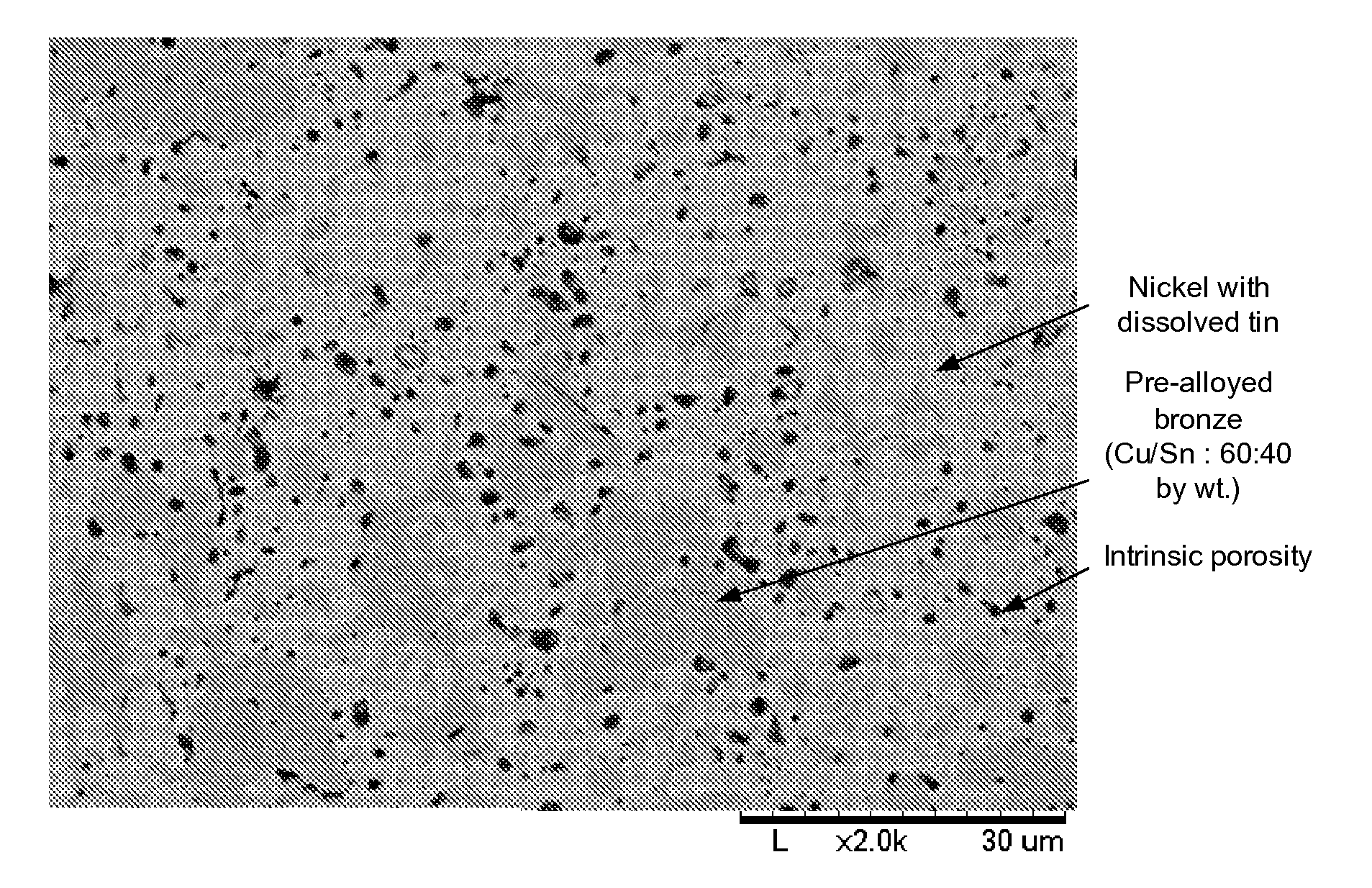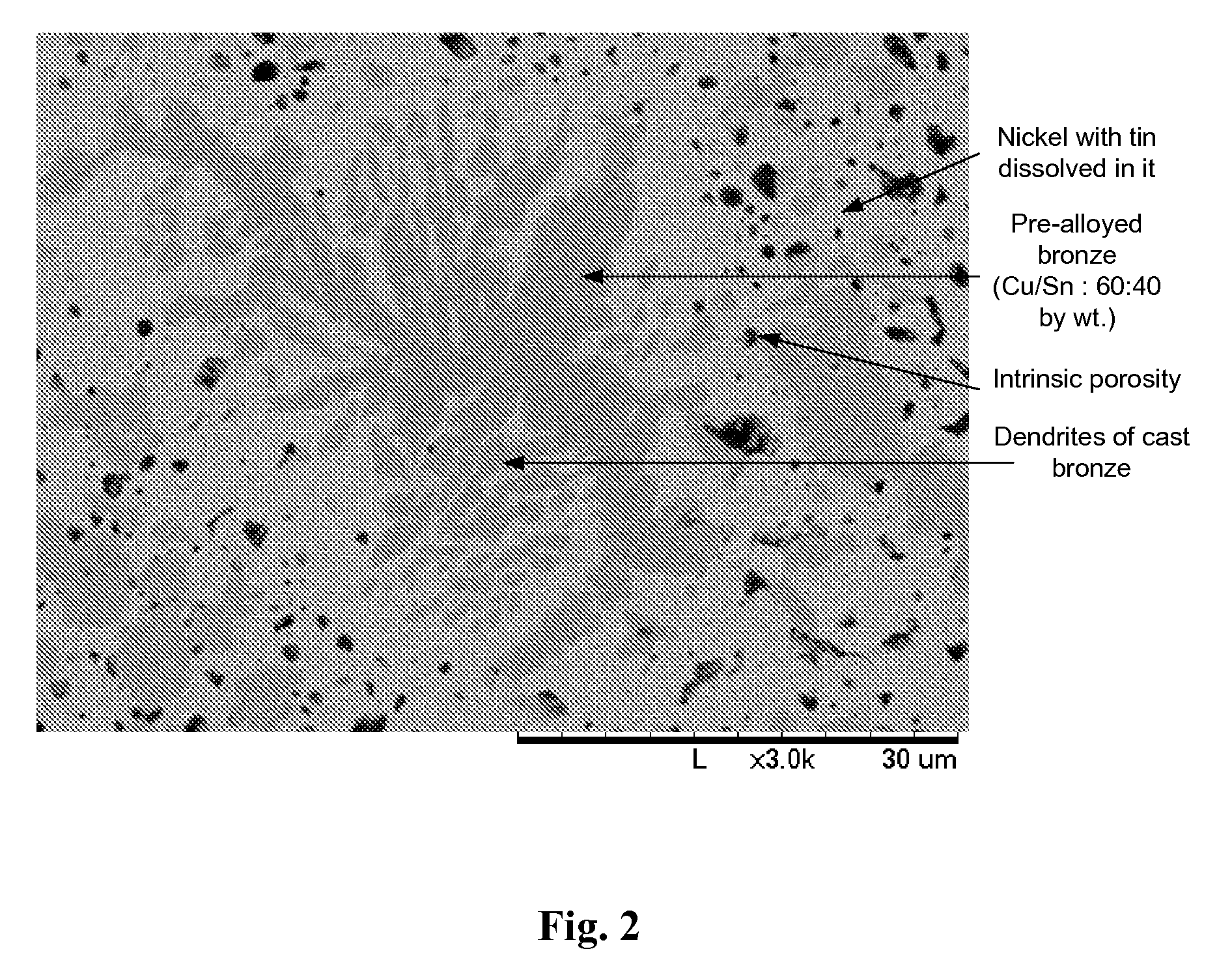Abrasive Slicing Tool for Electronics Industry
a technology of slicing tools and electronics, applied in the field of slicing materials with abrasives, can solve problems such as other properties of the wheel being compromised, and achieve the effect of superior wheel stiffness
- Summary
- Abstract
- Description
- Claims
- Application Information
AI Technical Summary
Benefits of technology
Problems solved by technology
Method used
Image
Examples
example 1
[0058]A powder metal alloy consisting of nickel, tin and bronze was manufactured via the hot-press technology. In more detail, 20.32 grams of nickel powder (obtained from AcuPowder International LLC, Union, N.J. as 123 Nickel) was blended with 7.11 grams of tin (also obtained from AcuPowder International LLC, Union, N.J. as 115 Tin) and 72.63 grams of pre-alloyed bronze powder (obtained from Connecticut Engineering Assoc. Corp., Sandy Hook, Conn. as CEAC Alloy 822 powder, 60 / 40 Cu / Sn by weight percent) in a Turbula® mixer (the resulting nickel, tin, and bronze composition had a weight percent ratio of 20.32 / 7.11 / 12.10). Then, 2.33 grams of diamond (obtained from Diamond Innovations, Worthington, Ohio as MBG 620 325 / 400 mesh) was added to the mix and Turbula® mixed again to provide a homogenous blend. The resulting mixture was then cold-pressed in a steel mold at 35 tsi, followed by hot-pressing in a graphite mold at 850° C. for 20 minutes at 1.6 tsi (3200 psi). Upon cooling, the res...
example 2
[0065]Example 2 refers to an example slicing wheel configured in accordance with another embodiment of the present invention (subsequently referred to herein as the Example 2 wheel). In particular, the Example 2 wheel was made from a composition including nickel, tin, and bronze in the weight percent ratio of 56 / 14 / 30. Diamond content was the same as in the Example 1 wheel. In general, and relative to the Example 1 wheel, the Example 2 wheel has a higher nickel content and exhibited a higher wear resistance. Due to the higher nickel content, the wheel was processed at 950° C.
[0066]The Example 2 wheel was tested for comparison of grinding data, in a similar fashion as was done with the Example wheel 1. Tables 5 and 6 detail the grinding results.
TABLE 5Grinding ResultsExample 2 wheelMXL 2115MBT-483CumulativeCumulativePower atCumulativePower atCumulativePower atcut lengthradial wheelend of runradial wheelend of runradial wheelend of run(meters)wear (μm)(Watts)wear (μm)(Watts)wear (μm)(...
example 3
[0069]Example 3 refers to an example grinding wheel comprising an elemental composition (subsequently referred to herein as the Example 3 wheel). In particular, the Example 3 wheel was made (without using a pre-alloyed bronze) from a composition including elemental nickel, tin, and copper in the weight percent ratio of 49 / 33 / 18. Recall that the pre-alloyed bronze used in the Example 1 wheel was a 60 / 40 by weight percent ratio of copper and tin, so both the Example 1 wheel composition and the Example 3 wheel composition have the same levels of nickel, tin and copper. Specifically, the amounts of various components used to produce the Example 3 wheel included 19.66 grams of nickel, 10.81 grams of tin, 7.22 grams of copper. Diamond content and forming methods were the same as with the Example 1 wheel.
[0070]The Example 3 wheel was compared to the Example 1 wheel (via grinding tests as previously described), with respect to bond durability and wheel life. Tables 7 and 8 detail the grindi...
PUM
| Property | Measurement | Unit |
|---|---|---|
| Temperature | aaaaa | aaaaa |
| Temperature | aaaaa | aaaaa |
| Temperature | aaaaa | aaaaa |
Abstract
Description
Claims
Application Information
 Login to View More
Login to View More - R&D
- Intellectual Property
- Life Sciences
- Materials
- Tech Scout
- Unparalleled Data Quality
- Higher Quality Content
- 60% Fewer Hallucinations
Browse by: Latest US Patents, China's latest patents, Technical Efficacy Thesaurus, Application Domain, Technology Topic, Popular Technical Reports.
© 2025 PatSnap. All rights reserved.Legal|Privacy policy|Modern Slavery Act Transparency Statement|Sitemap|About US| Contact US: help@patsnap.com



